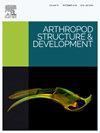It's ‘claw’-some: Ontogenetic claw shape changes in mites (Acari, Oribatida) as a consequence of ecological shifts
IF 1.3
3区 农林科学
Q2 ENTOMOLOGY
引用次数: 0
Abstract
Claw characteristics of oribatid mites are strongly correlated with environmental factors and these characters remain constant throughout development when immatures and adults share the same ecology and lifestyle. In the present study, claw traits of oribatid mite species with constant ecology were compared with those of species showing a clear ecological shift between juvenile and adult stage. The arboreal Sellnickia caudata and the saxicolous Niphocepheus nivalis dwell in the same microhabitat during their life-cycle, whereas immatures of the terrestrial Carabodes areolatus and Mycobates carli, as well as of the aquatic Hydrozetes lemnae, are, in contrast to their adults, endophagous, meaning they feed and burrow within lichen and plant tissue. We performed a geometric morphometric investigation of their claws and could reveal significant differences in the claw shapes of immatures and adults of all species, except for N. nivalis. Claws of the endophagous juveniles of C. areolatus, M. carli and H. lemnae are generally sharper and higher than those of their adult counterparts. The burrowing lifestyle of the immatures apparently necessitates such specific claw morphologies. Despite having a constant ecology, the arboreal S. caudata also shows distinct differences between immature and adult claw traits, with juveniles possessing stronger curved and sharper claws. But immature stages also possess an additional tarsal adhesive pad which lacks in the adult stage. The presence or absence of this additional adhesive pad apparently requires changes in claw morphology to allow firm attachment on diverse plant surfaces. The present results demonstrate that claw characteristic can change during the development depending on the given ecological factors faced by each developmental stage and depending on the presence of additional attachment devices.
它的 "爪 "很美:螨虫(螨类,Oribatida)在个体发育过程中的爪形变化是生态变化的结果。
甲脚螨的爪部特征与环境因素密切相关,在幼年和成虫生活环境相同的情况下,爪部特征在整个发育过程中保持不变。本研究比较了具有恒定生态环境的甲螨和具有明显生态变化的甲螨的爪部性状。树栖的Sellnickia caudata和沙栖的Niphocepheus nivalis在它们的生命周期中生活在同一个微生境中,而未成熟的陆生Carabodes areolatus和mycoates carli以及水生Hydrozetes lemnae,与它们的成虫相反,是自食的,这意味着它们在地衣和植物组织中觅食和挖洞。我们对它们的爪子进行了几何形态调查,可以发现除nivalis外,所有物种的未成熟和成虫的爪子形状存在显著差异。内食幼鱼的爪通常比成年鱼的爪更尖、更高。幼龙的穴居生活方式显然需要这种特殊的爪子形态。尽管具有恒定的生态环境,但树栖尾螺在未成熟和成年的爪子特征上也表现出明显的差异,幼年的爪子具有更强的弯曲和更锋利。但未成熟阶段也有一个额外的跗骨粘连垫,这在成虫阶段是缺乏的。这种附加的粘接垫的存在与否显然需要改变爪的形态,以便在不同的植物表面上牢固地附着。目前的研究结果表明,爪特征在发育过程中会发生变化,这取决于每个发育阶段所面临的给定生态因素和附加附着装置的存在。
本文章由计算机程序翻译,如有差异,请以英文原文为准。
求助全文
约1分钟内获得全文
求助全文
来源期刊
CiteScore
3.50
自引率
10.00%
发文量
54
审稿时长
60 days
期刊介绍:
Arthropod Structure & Development is a Journal of Arthropod Structural Biology, Development, and Functional Morphology; it considers manuscripts that deal with micro- and neuroanatomy, development, biomechanics, organogenesis in particular under comparative and evolutionary aspects but not merely taxonomic papers. The aim of the journal is to publish papers in the areas of functional and comparative anatomy and development, with an emphasis on the role of cellular organization in organ function. The journal will also publish papers on organogenisis, embryonic and postembryonic development, and organ or tissue regeneration and repair. Manuscripts dealing with comparative and evolutionary aspects of microanatomy and development are encouraged.

 求助内容:
求助内容: 应助结果提醒方式:
应助结果提醒方式:


